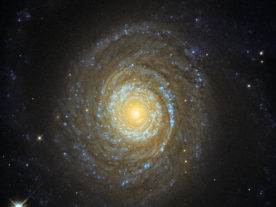Mystery Asteroid Belt Object Really a Binary Asteroid
Back in 2011 a Panoramic Survey Telescope and Rapid Response System or PanSTARRS survey detected an object in the asteroid belt displaying comet-like activity.
So along with being labeled an asteroid, when it was discovered five years earlier, scientists also gave it a comet designation.
After analyzing a 2016 Hubble Space Telescope image, an international group of scientists now says this object is actually a binary asteroid – two asteroids nearly identical in both mass and size orbiting each other at a distance of 96 kilometers.
They also found that the object does have comet-like features including bright halo of material or coma, along with a long tail of dust.
Jessica Agarwal from Germany’s Max Planck Institute says the team detected strong signs that water ice on the objects was quickly vaporized due to intense solar heating, similar to how the tail of a comet is created.

Bedrest volunteer during a study at the MEDES space clinic in Toulouse, France. Volunteers lie in beds with the head end tilted down 6º for months, keeping at least one shoulder on their bed at all times. (CNES/MEDES–E.Grimault, 2017)
European Space Agency Readies Next Bed Rest Study
The European Space Agency is getting ready for their next bed-rest study, which involves subjects staying in bed for 60 days.
ESA scientists want to find out if a mix of antioxidants and vitamins might help astronauts fight the side effects of living in space.
The study is meant to mimic changes astronauts must endure in space.
While going to bed might seem like a nice restful experiment to sign up for, keep in mind that test subjects must keep at least one shoulder on their bed at all times for 60 days.
And the bed they’ll lie in will have the head end tilted down 6° for the entire time, something that can make blood and fluids move to the head.
So, would you sign up for this test?
Partial Sleep Deprivation Eases Depression Symptoms
Based on a number of studies sleep deprivation has a number of negative health effects. These include high risks of heart disease, kidney disease, high blood pressure, diabetes, stroke and even obesity.
Back in the 1990’s researchers found that total sleep deprivation, which is about 36 hours of forced wakefulness, also provided a clinical improvement in symptoms of depression.
But a new report, based on an analysis of more than 2,000 studies, by researchers at the University of Pennsylvania, found that partial sleep deprivation also quickly reduced the symptoms of depression in 40 to 60 percent of those observed in the studies.
The researchers defined partial sleep deprivation as three to four hours of sleep followed by being kept awake for 20 to 21 hours.
Currently, depression is commonly treated with anti-depression medication and/or psychotherapy.

Brown researchers have found new evidence of ice sheets in permanently shadowed craters near the north pole of Mercury. (Head lab/Brown University)
Ice on Mercury
When you think of Mercury, the closest planet to the Sun, you probably don’t think of it as having any ice.
But, research over the last thirty years has suggested that ice might be found inside the planet’s craters, where it’s shielded from the rays of the Sun.
In a new study, researchers from Brown University found three craters near the planet’s North Pole that seems to hold large accumulations of surface ice.
Along with these larger deposits, the Brown researchers say they have also found evidence of smaller collections of ice hidden not only inside craters but also in shadowed terrain between craters.
The researchers say that while these additional deposits might be small individually, they could add up to a lot more ice on Mercury that had not been unaccounted for.
Scientists first suspected ice on Mercury back in the 1990s, when they spotted highly reflective areas within several craters near its North Pole.

Matthijs Smit of the University of British Columbia examines ancient rocks from the deep crust in Norway during the summer of 2017. (Matthijs Smit)
Shifting Earth’s Crust May Have Seeded Atmospheric Oxygen
Scientists say that for the first half of Earth’s history there was virtually no real free or breathable oxygen in the atmosphere.
While some oxygen was being produced by early organisms through photosynthesis, most of it was being absorbed by minerals such as olivine.
Then about 2.3 billion years ago, Earth’s atmosphere began its first substantial and permanent inflow of breathable oxygen, with the so-called great oxidation event.
According to a new study, this event took place around the same time as changes were being made in the Earth’s crust.
The study suggests as the crust evolved, the olivine nearly disappeared.
Without that mineral absorbing so much free oxygen, the gas was able to accumulate in our atmosphere, providing the kind of air we know and need today.
























Comments are closed.